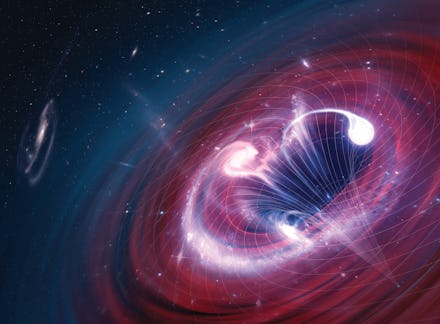The vibrations from the most massive collision of black holes ever recorded just hit Earth

On May 21, 2019, two observatories picked up a surprising cosmic signal. Vibrations felt by the Earth early in the morning were identified by the LIGO observatory in the United States and the Virgo in Italy. By the time the vibrations reached the planet, it was barely enough to get noticed. But according to a study published Wednesday in the journal Physical Review Letters, that signal was the long-surviving mark of what is believed to be the largest black hole collision ever identified.
Scientists identified the signal, which was named GW190521, as gravitational waves, or disruptions to the fabric of space-time that are sent into action as the result of massive cosmic occurrences. In this case, it is believed that the waves are a sort of aftershock produced by a collision between two black holes of the nearly unfathomable size that happened more than seven billion years ago, and more than 17 billion light-years away from Earth. The black holes are believed to have been 66 and 85 times the size of our sun respectively and came together to create a unified black hole that measured in at 142 times more massive than the sun. As the black holes merged, they produced an explosion that released eight times the amount of energy that is contained within all of the sun's atoms. That energy took the form of gravitational waves, which eventually found their way to Earth after billions of years.
That long-traveling signal is the best insight that humans have gotten into what is now believed to be one of, if not the largest explosion that the universe has ever experienced. According to National Geographic, scientists say the black hole collision created the equivalent energy to what would be generated by setting off more than a million billion atomic bombs every single second for 13.8 billion years.
On top of serving as a bit of insight into the otherwise unimaginably large explosion that once shook up space-time, the signal from this black hole collision has provided scientists with new insight into black holes. Prior to the gravitational waves being observed, researchers had been unable to confirm the existence of intermediate-mass black holes. All previously observed black holes were either tens of times more massive than our sun or were supermassive black holes, measuring millions to billions of times more massive than the sun. The black holes that collided seven billion years ago appear to occupy the intermediate range, which is something that scientists have long wondered about.
In addition to answering a question about the existence of intermediate black holes, this discovery also presents some new uncertainty, because the black hole with the mass 85 times greater than the sun theoretically shouldn't exist. Black holes are often created when massive stars die and explode, but scientists thought that stars that measure 60 to 130 times more massive than our sun would be unable to collapse into a black hole. The gravitational waves suggest otherwise. Scientists aren't sure what to make of this exactly, though a companion paper published in the journal The Astrophysical Journal Letters suggested that the intermediate black hole could have been the result of two smaller black holes merging together, rather than being the product of a single, collapsing massive star.
There’s still a lot about our solar system and space in general that we know little about. So much so that even a seemingly small vibration from billions of years ago can amount to a massive bit of insight into history that occurred billions of years ago.